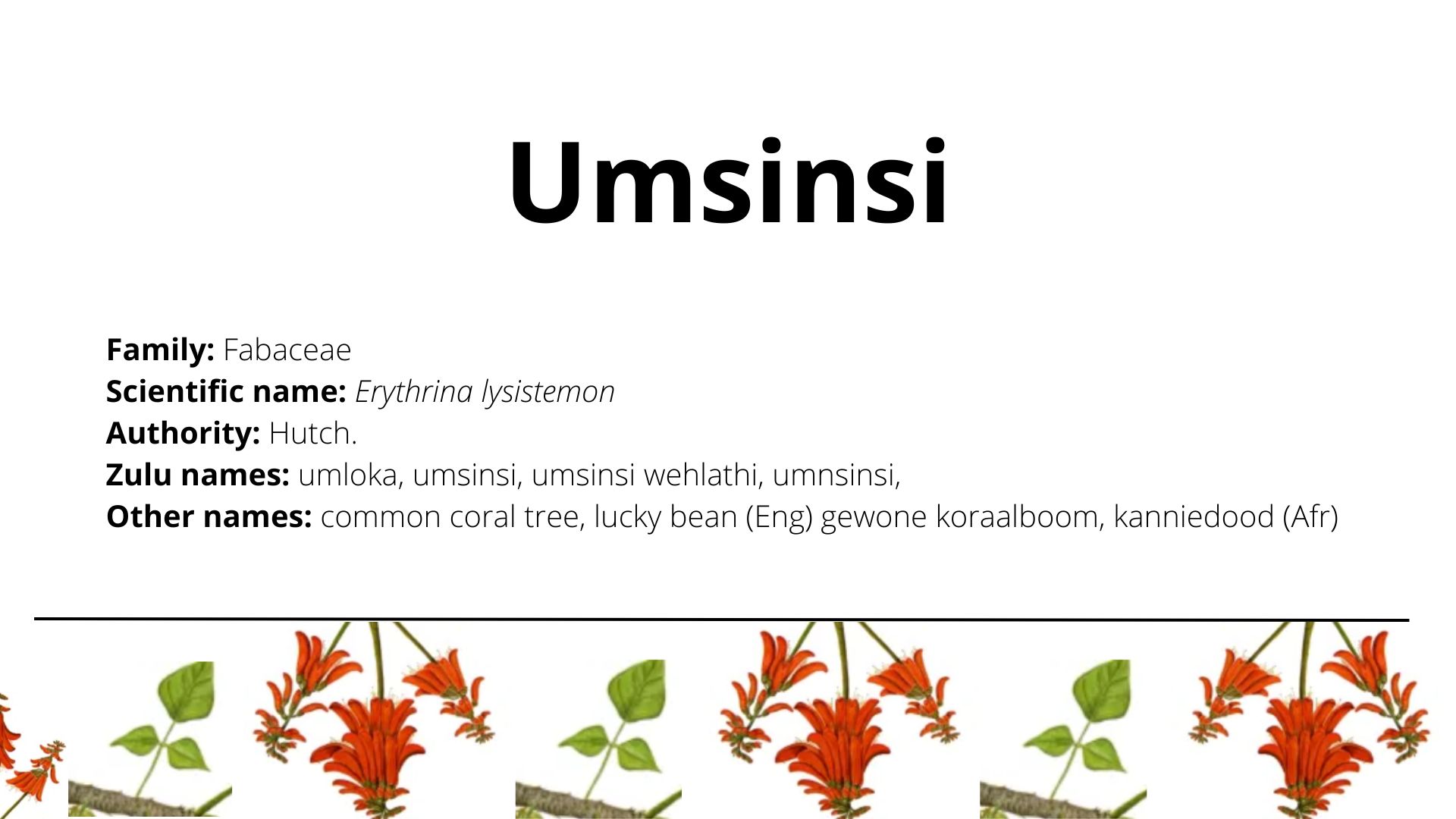Family: Fabaceae
Scientific name: Erythrina lysistemon
Authority: Hutch.
Zulu names: umloka, umsinsi, umsinsi wehlathi, umnsinsi,
Other names: common coral tree, lucky bean (English) gewone koraalboom, kanniedood (Afrikaans)
Description: E. lysistemon is a fast growing medium-sized tree that is indigenous to South Africa and grows in the woodland and thicket habitats. It has large trifoliate leaves with heart-shaped leaflets, scarlet flowers, and pods containing scarlet seeds.
The flowers, pods, and seeds contain a high amount of Erythrinaline alkaloids, when ingested (in high doses) can cause respiratory failure, paralysis, and death.
Uses:
- The plant is cultivated on the graves of chiefs as it is believed to protect them in the afterlife.
- The seeds are used as beads to make anklets, bracelets, and necklaces lucky charms.
- The bark is added to bathing water in order to protect them from their enemies.
- The bark is used to protect from sorcery.
- The bark is used to induce a trance. The plant is used to treat nervous complaints, such as anxiety and mental disturbances.
- The bark is used to make an infusion to aid the birthing process.
- The bark infusion is administered orally to newborn babies to get rid of udende, a thick saliva in order to facilitate breathing and breastfeeding. The bark infusion is administered as an emetic to treat isela in babies.
- The bark is burnt and the ash is used (as an antibacterial) to disinfect open wounds.
- The bark infusion is used to treat internal and external wounds.
- The bark is used to treat skin related conditions, such as umzimba omubi.
- The bark is used to treat pain, such as earache, headache, toothache, and labour pains. The bark infusion is administered warm and gargled to treat toothache. The bark infusion is used to treat the infected ear of a child dripping of pus-bark.
- The bark is mixed with Cussonia plant to make a purifying emetic. The emetic is taken to treat poisoning and allergies.
- The fresh leaves are used to treat sore feet and cracked heels.
- The crushed leaves are used to remove maggots on wounds.
- The roots are used to make a decoction that is applied as poultice on bruises and sprains.
- The plant is used to treat symptoms of menopause.
- The plant is used to treat arthritis and rheumatism. The bark is added as an ingredient in the preparation of umhlabelo to hasten bone repair, after it has been broken or fractured.
- The plant is used to make poultice to treat abscesses, sores, and wounds.
- The plant is used to treat diarrhoea, dysentery, and stomach-ache, cramps, and ulcers.
- The wood is used to make canoes, feeding troughs, fishing nets, floats, rafts, and shingles for roofing.
- The plant is cultivated as a hedge around a homestead, waterholes, and kraals.
- The plant is cultivated as an attractive ornamental tree in gardens and parks.
The flowering of the tree has been regarded as a sign for the people to start planting their crops.
References and further reading:
- Boon, R., 2010. Pooley’s trees of eastern of South Africa: A complete guide, second edition. Flora and Fauna Publications, Durban.
- Coates Palgrave, M., 2002. Trees of southern Africa, third edition. Struik, Cape Town.
- Hennessy, E.F., 1975. Erythrina in Southern Africa. Veld & Flora, 61(3), pp.20-23.
- Hutchings, A., Scott, A.H., Lewis, G., and Cunningham, A., 1996. Zulu medicinal plants. Natal University Press, Pietermaritzburg.
- Mabogo., D.E.N., 1990. The ethnobotany of the VhaVenda. M.Sc. dissertation, University of Pretoria, Pretoria.
- Mahwasane, S.T., Middleton, L. and Boaduo, N., 2013. An ethnobotanical survey of indigenous knowledge on medicinal plants used by the traditional healers of the Lwamondo area, Limpopo province, South Africa. South African Journal of Botany, 88, pp.69-75.
- Mvondo, M.A., Njamen, D., Fomum, S.T., Wandji, J. and Vollmer, G., 2011. A postmenopause-like model of ovariectomized Wistar rats to identify active principles of Erythrina lysistemon (Fabaceae). Fitoterapia, 82(7), pp.939-949.
- Nyoni, L., 2021. A comparative study of the relationship between the applications of Erythrina lysistemon (Umsinsi) within the traditional African and homeopathic medicinal systems. Durban University of Technology, Doctoral dissertation.
- Palmer, E., and Pitman, N., 1972a. Trees of southern Africa Vol.1. Balkema, Cape Town.
- Pujol, J., 1990. Natur Africa: The Herbalist handbook. Lean Pujol Natural Healers Foundation, Durban.
- Walker, J., 1996. Wild flowers of KwaZulu-Natal. W.R. Walker Family Trust, Pinetown.

